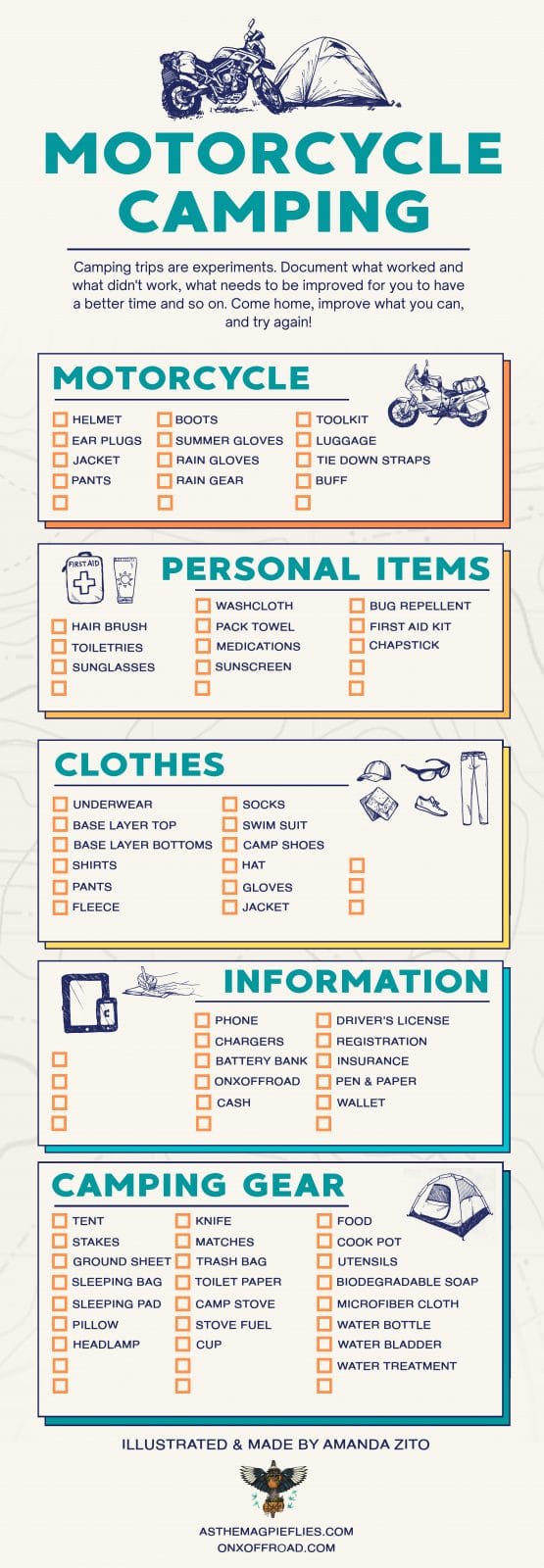How to Plan an Off-Road Camping Trip Like a Pro
Word and Photos by: Amanda Zito | As the Magpie Flies
Edited By: Kate Weber
Dialing in your home away from home is always a highly personal journey, and if your home is atop a motorcycle, the challenge gets even steeper to stay comfortable without much space. Amanda Zito has crisscrossed backroads and backcountry trails on a bike, camping and cooking along the way, making her the perfect person to show anyone thinking about taking an off-road camping trip the ropes. Here’s her guide to getting started, but even experts can take a peek for ideas about how they might continue to evolve their packing list. Get started to learn how to use onX Offroad to plan your route and find campsites, what to pack, tips to stay safe on the road and in camp, and more. Whether your off-road vehicle of choice has two wheels or four, this guide will get you on the trail.
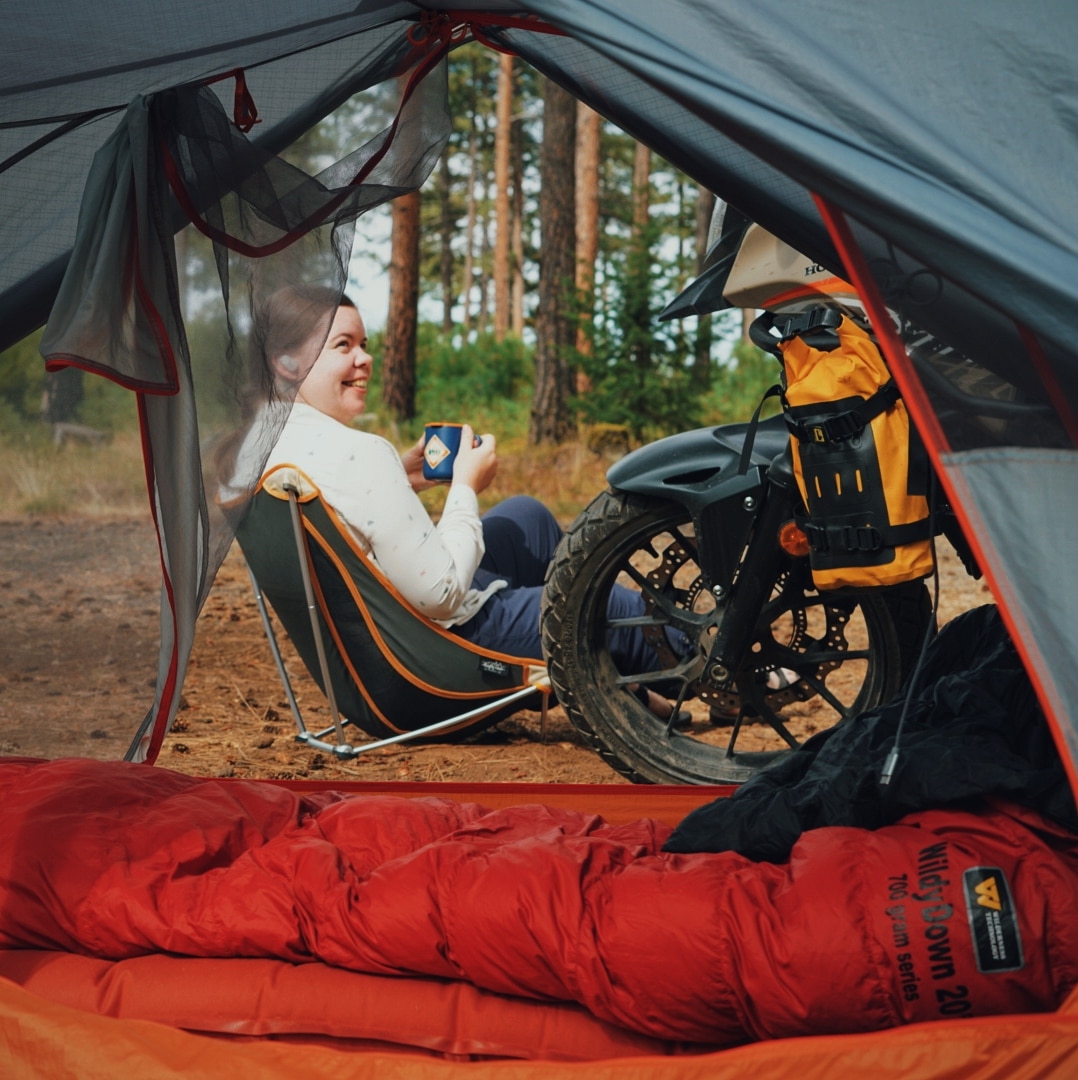
Find Your Off-Road Camping Style
Everyone camps and travels differently. Everyone needs different things to feel comfortable. It’s important to approach your first few camping trips as experiments, where you document what worked and what didn’t work, what needs to be improved for you to have a better time, and so on.
For me, motorcycle camping is a fantastic way to overland and experience everything our wonderful public lands have to offer. Fuel efficiency for motorcycles is amazing. Seriously, it could cut down your projected fuel costs for a trip by half at least. Being exposed to the elements means there’s no barrier between you and the world around you. Of course, motorcycles also require a slimmed-down packing list, so if your preferred vehicle is a big overlander, you can travel with more gear (or less ultralight versions). In general, while this guide is geared towards a moto-camping trip, it can be a good jumping-off point for other types of vehicles, too.
Get Amanda’s Motorcycle Camping Checklist
But it doesn’t matter what type of vehicle you have if you don’t if you don’t know how to plan your route or find camping.
plan your next camping adventure with confidence
With detailed off road trail maps, including campsites and dispersed camping, onX Offroad is the perfect camping companion.
Plan Your Route & Find Dispersed Camping Spots
You can either plan your route and then find camping along that route, or your route can be created by traveling from campsite to campsite. It’s important to know how to do both, in case you are in a pinch and the spot you planned for is full or closed. Good news: onX Offroad shows you campsites on your map! There are a few ways you can find camping using the App. I usually just scan the map and look for the tent icons—the icons show both designated campgrounds and places you can disperse camp.
And remember, most improved campsites—private and managed by state and federal agencies—are able to take both reservations and day-of arrivals, but dispersed camping is strictly first-come, first-served. So it’s wise to have backup options or plan to arrive at a hoped-for site earlier in the day so you’re not scrambling for another location in the dark. Want to brush up on dispersed camping? I have a handy video explaining what dispersed camping is and the rules you need to follow here.
Use the App’s Route Builder Tool to plan your trip with snap-to-routing on roads and trails (or draw straight lines between points if you’re wayfinding on the ground through dunes or other OHV areas) and download it as an Offline Map so you can follow it whether or not you have cell service.
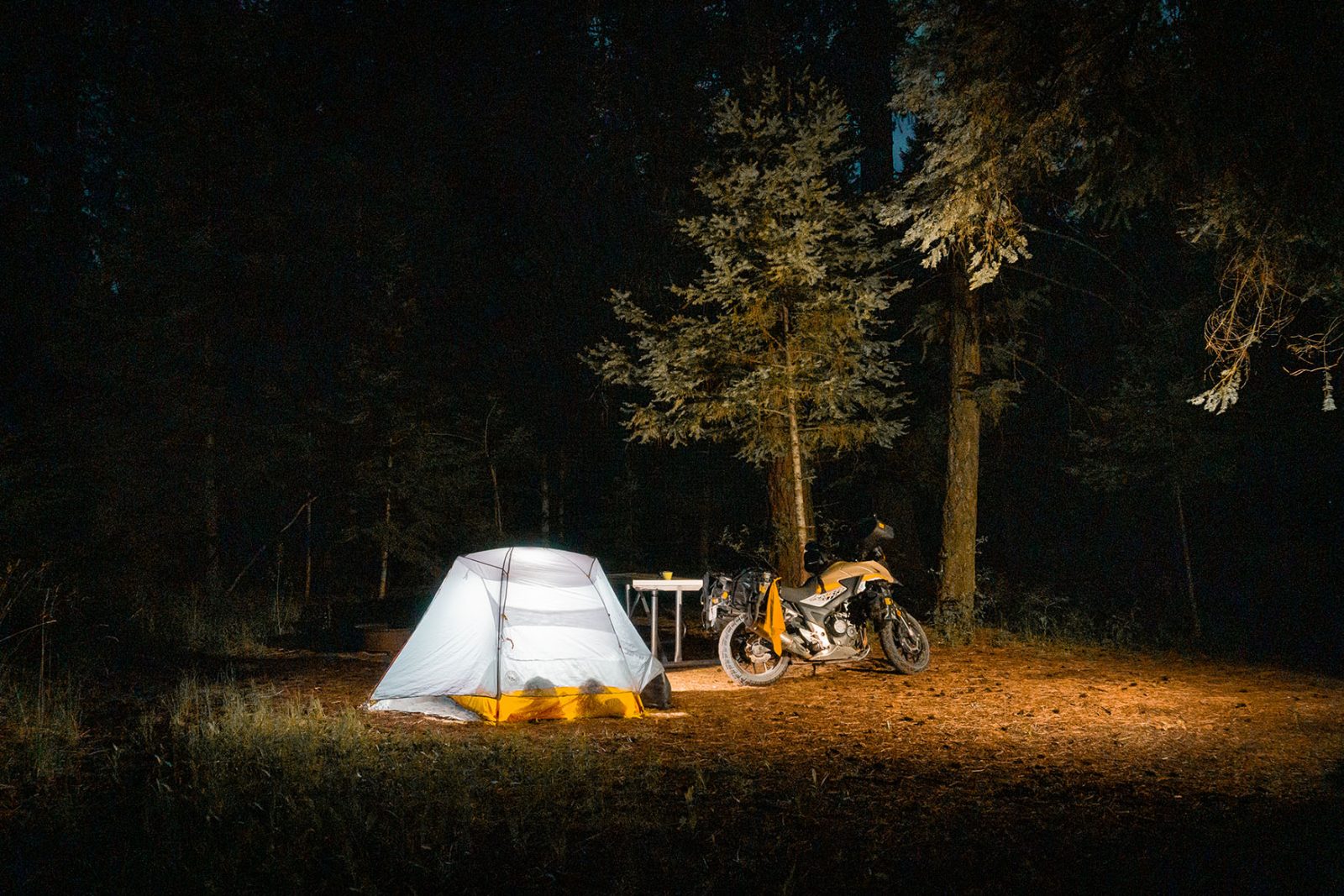
Practice Leave No Trace Camping
Remember to Leave No Trace, and always leave a campsite better than you found it. Do not throw your trash or beer cans in the fire pit—it’s not a trash can. Pack it out and dispose of it properly. Do not leave toilet paper in the bushes or in your cat hole (how to poop in the woods). Wild animals often dig up your waste and will spread that toilet paper all over. It does not compost as fast as you think it does. If you have to camp in a place that doesn’t have toilets, you should have a separate Ziploc bag to pack out your used toilet paper—or look into a backcountry bidet.
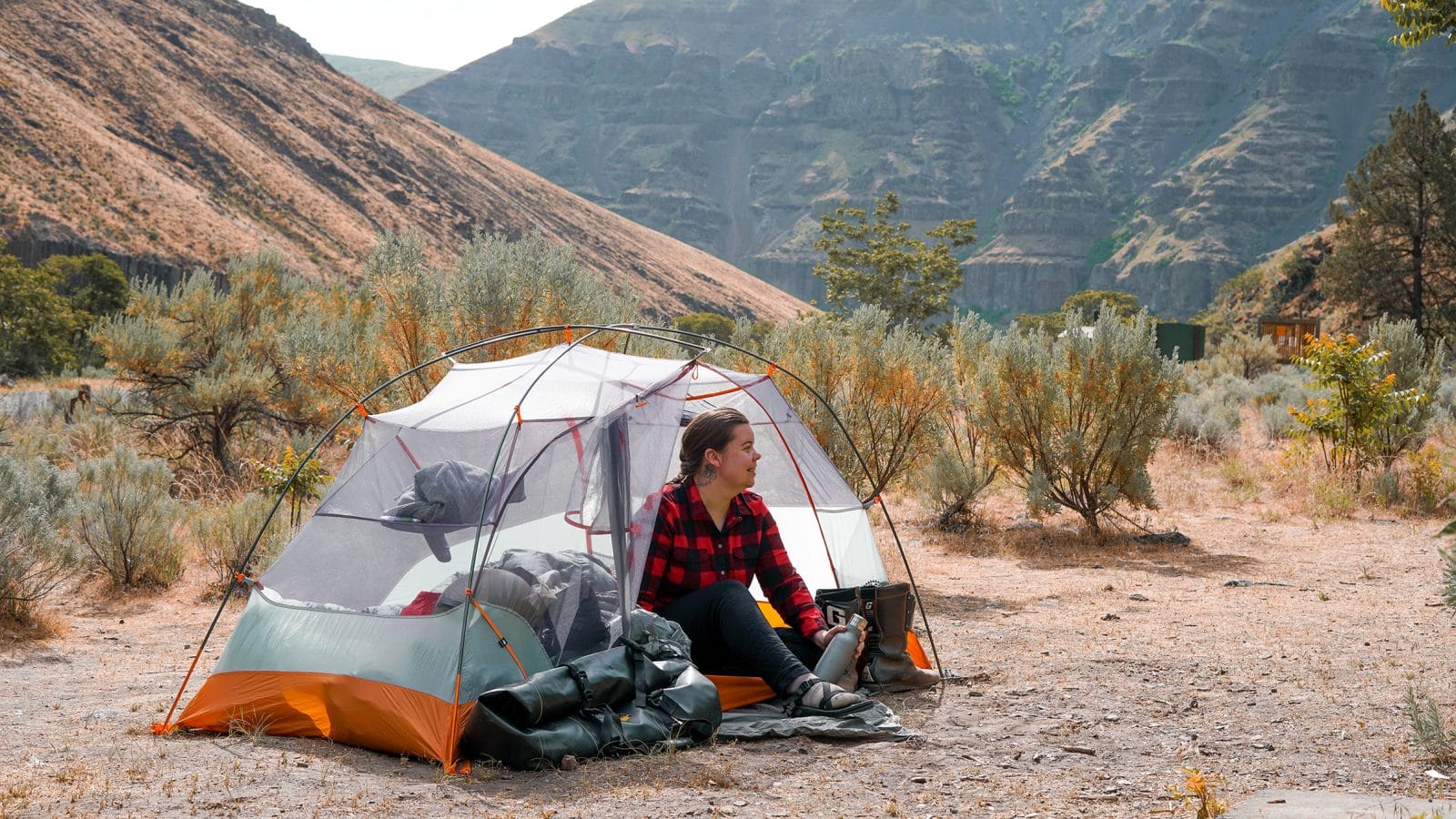
Off-Road Camping Essentials
There’s a list of items in backpacking called the 10 essentials. They can be applied to camping as well.
- Navigation: map, compass, or a GPS device or satellite messenger. onX Offroad maps work offline — just remember to download your maps before you go. It’s also good to have a backup map just in case you lose your phone.
- Headlamp
- Sun protection: sunglasses, sun-protective clothes and sunscreen. You can still get sunburned on your face even if it is overcast.
- First Aid Kit: including insect repellent, burn care, and some kind of wrap to secure broken bones.
- Knife & Gear Repair Kit
- Fire: matches and a lighter. Always carry two ways to light a flame.
- Shelter
- Extra Food: I always carry an extra can of soup and some energy bars just in case I get stuck somewhere unexpectedly.
- Extra Water: Hydration is so, so important. Having a water bottle or a hydration bladder is good, but you should also have some kind of water storage like a dromedary bag, and a way to treat water.
- Extra Clothes
Other items to consider taking:
- Battery Pack to charge your phone.
- Pack Towel
- Camp Shoes: Sandals or other packable shoes.
- Biodegradable Soap: This would ideally be something you would remember to bring as a part of your camp kitchen, but it’s important enough that I wanted to add it here.
- Gallon Ziploc bag for trash: Or a larger bag to carry out your trash if you’re in a group.
- Compact Camp Chair: Many people enjoy the luxury of not sitting on the ground. If you’ll be camping at a developed campground with picnic tables this might be overkill though.
Some notes on safety: You should also consider carrying a set of tools for your motorcycle (or the vehicle of your choice). Even if you don’t know how to use those tools, or how to work on your bike, it is better to carry them in the chance that you need help and run into someone who knows how to use them. Make sure your tools are appropriate for your motorcycle as well whether that’s Metric or SAE. I have a whole video on what to do if you break down that is linked in the Additional Resources section.
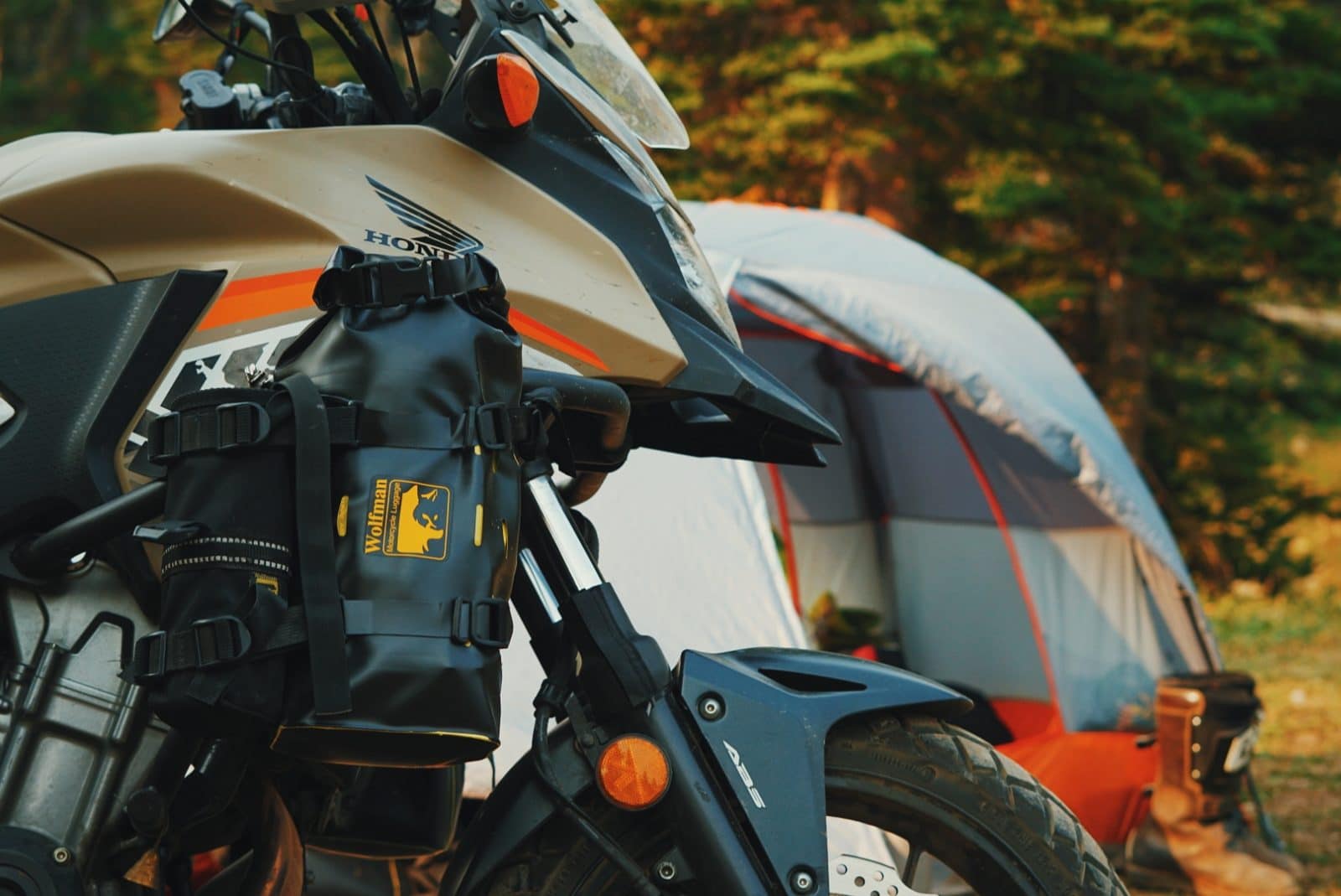
Off-Road Camping Gear
At the core of it, you just need a shelter and a sleep system to camp. So let’s start with that.
Shelter
I recommend beginner motorcycle campers start with a tent as their shelter and branch out to other kinds of shelters (like hammocks, tarps, a bivy, or pull-behind pop-up trailers) if they interest you.
Most entry-level backpacking tents around the $200 mark are where I recommend people start.
Wait for sales, like Black Friday, buy used, or rent if you’re really unsure if you’ll like camping or not. (I’ll talk about more resources for buying quality camping gear on a budget a little later in this post!)
Yes, there are cheaper dome tents out there from big box stores. I discourage people from going this route because if it turns out you do like camping, you’ll want to upgrade your tent sooner than later. Speaking from experience, these cheap tents will deteriorate quickly, are more frustrating to set up, and will not hold up to the elements over multiple trips.
If you’re camping by yourself a two-person tent is a good place to start, if you’re taking a partner with you, think about getting a three-to-four person tent. Single-person tents will not have space for you, your sleep system, AND your gear.
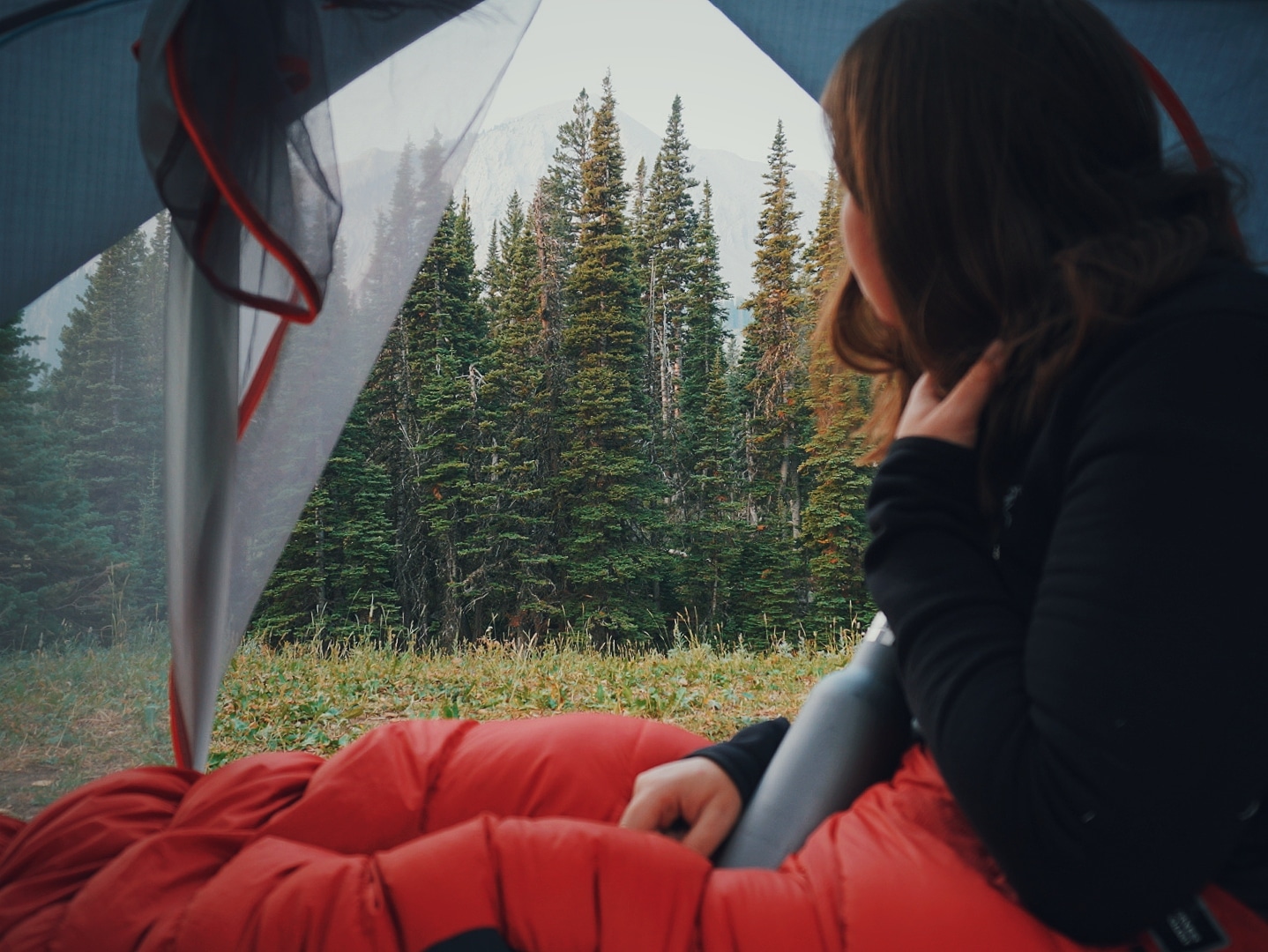
Sleeping Bags & Pads
In general, there are two different kinds of sleeping bags you can get: down-filled or synthetic-filled. They come in all different shapes, sizes, and temperature ratings.
As a general rule, I recommend most people get a 20 or 30-degree sleeping bag for their first bag. If you live in a tropical area, or a place where the temperature rarely drops below 60 at night, you could go for a 40-50 degree bag.
- Down sleeping bags are lighter, pack smaller, and you get a higher warmth to weight ratio. They also tend to be more expensive. The argument many have against down sleeping bags is that if they get damp or wet they lose their insulating properties, whereas synthetic sleeping bags will still insulate when wet. My counter argument: If your sleeping bag gets wet you’re not going to want to sleep in that even if it did still insulate you. It would be so uncomfortable you wouldn’t sleep and the dampness would transfer to your body, which if it was cold and windy, could lead to a threat of hypothermia.
- Synthetic Sleeping Bags tend to be a bit bulkier, heavier for the temperature rating that you get, and the warmer it is the bigger and heavier it is. However, they also tend to be cheaper than down.
- Sleeping pads are just as vital to your sleep system as your sleeping bag. Whether that’s a closed-cell foam pad, self-inflating pad, or an air pad. Sleeping Pads have a thing called an R Value rating, which rates how well the sleeping pad will insulate you from the ground. 0 being the lowest rating which means there’s no insulation in it so it’s only suitable for conditions 50°F and warmer. All the way up to 5.5 and higher which means it will keep you insulated in very cold temperatures. In general, I recommend beginners to use an insulated air pad with an R Value of at least 2 if not 3 or higher. As many of the other options of sleeping pads are very large and bulky to try and pack on a motorcycle.
Clothing
Layering is important no matter what time of year you’re going camping. You’ll want to take the weather into account and plan appropriately. I always recommend bringing one or two warm layers even if it’s hot when you leave, so you’re not caught off guard when the temperature drops at night, or if it suddenly decides to storm. Better to carry a puffy down jacket and not need it than leave it at home and be uncomfortably cold once the sun goes down.
Invest in base layers made of merino wool or synthetic fabrics, fleece jackets instead of cotton hoodies, and down packable jackets, instead of bulky layers. Remember the rule, no cotton in the backcountry.
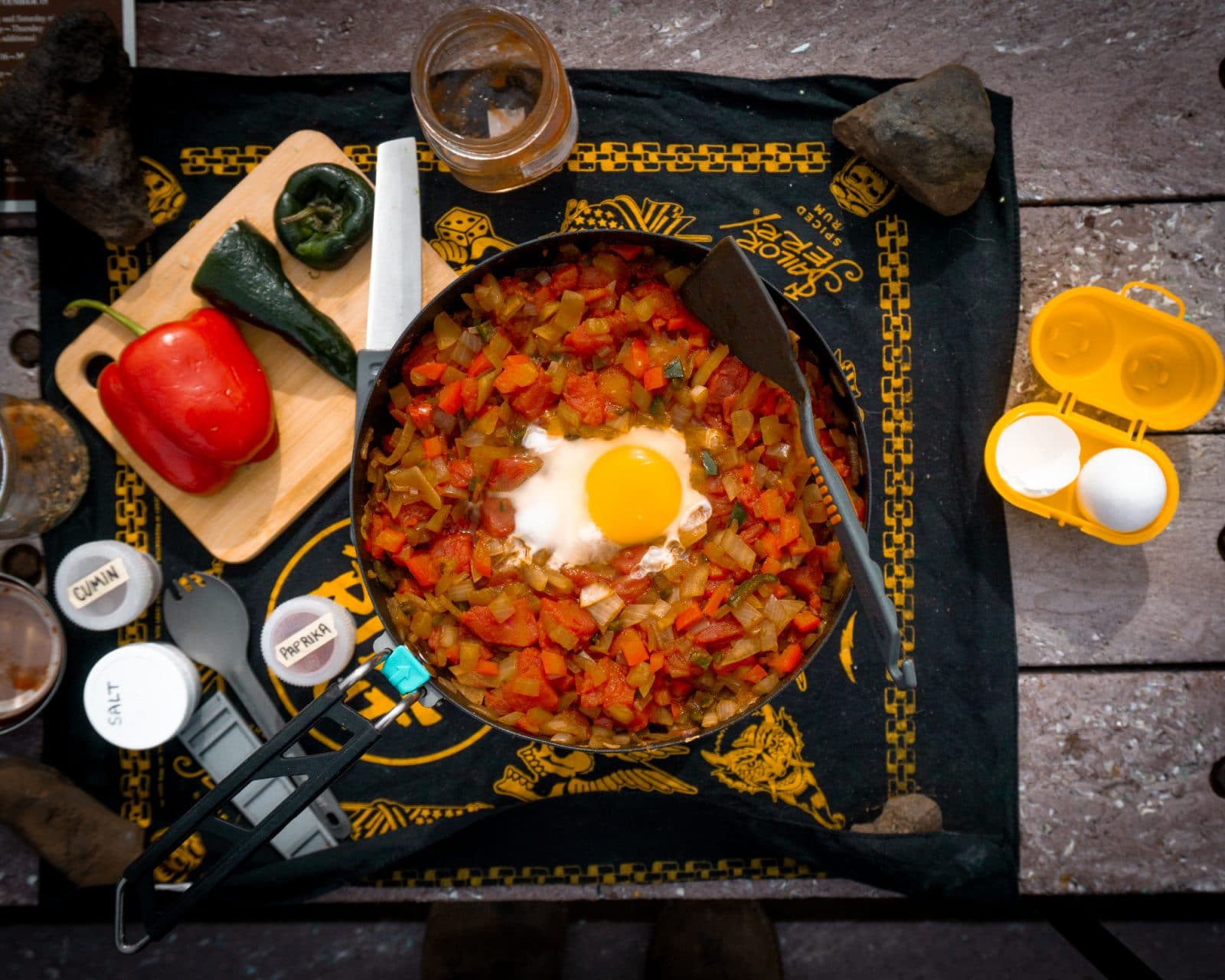
Cooking Gear for Camping
It’s a great idea to have some kind of compact camp stove and pot to make hot water so you can make yourself your beverage of choice and maybe heat up some water to make some dehydrated meals or heat up a can of soup.
As you get the hang of camping, you can branch out and experiment with making more ‘complex’ meals at camp. I have a whole video all about setting up a versatile camp kitchen that works for YOU here where I dive into all the different kinds of pots, camp stoves, fuel types, etc.
Off-Road and Camping GPS
Knowing where you’re headed and where you’ve been are critical bits of information on the road and trail, so a GPS device and knowledge of how to use it is a core piece of any off roader’s gear. Understanding how to read digital maps—and the tools some come with—can also help you find new places to roam with your rig and spend the night.
A standalone GPS device is popular with many motorcyclists as phones can’t handle the rigors of a handlebar mount, but plenty of options exist. For most off-roaders, though, they’re already carrying a GPS around—whether they realize it or not. All modern smartphones include a GPS chip inside them, which communicates with satellites—not cell towers—to triangulate your position anywhere in the world. So even when you’re out of service, the GPS is able to show your position. If you’re using a dedicated off-roading app like onX Offroad, you have the ability to download Offline Maps for the areas you’re traveling, which allows that familiar blue GPS dot to display your locations no matter what. You can also use an App to find campsites, services, points of interest, new routes, or make adjustments to your plan as you go.
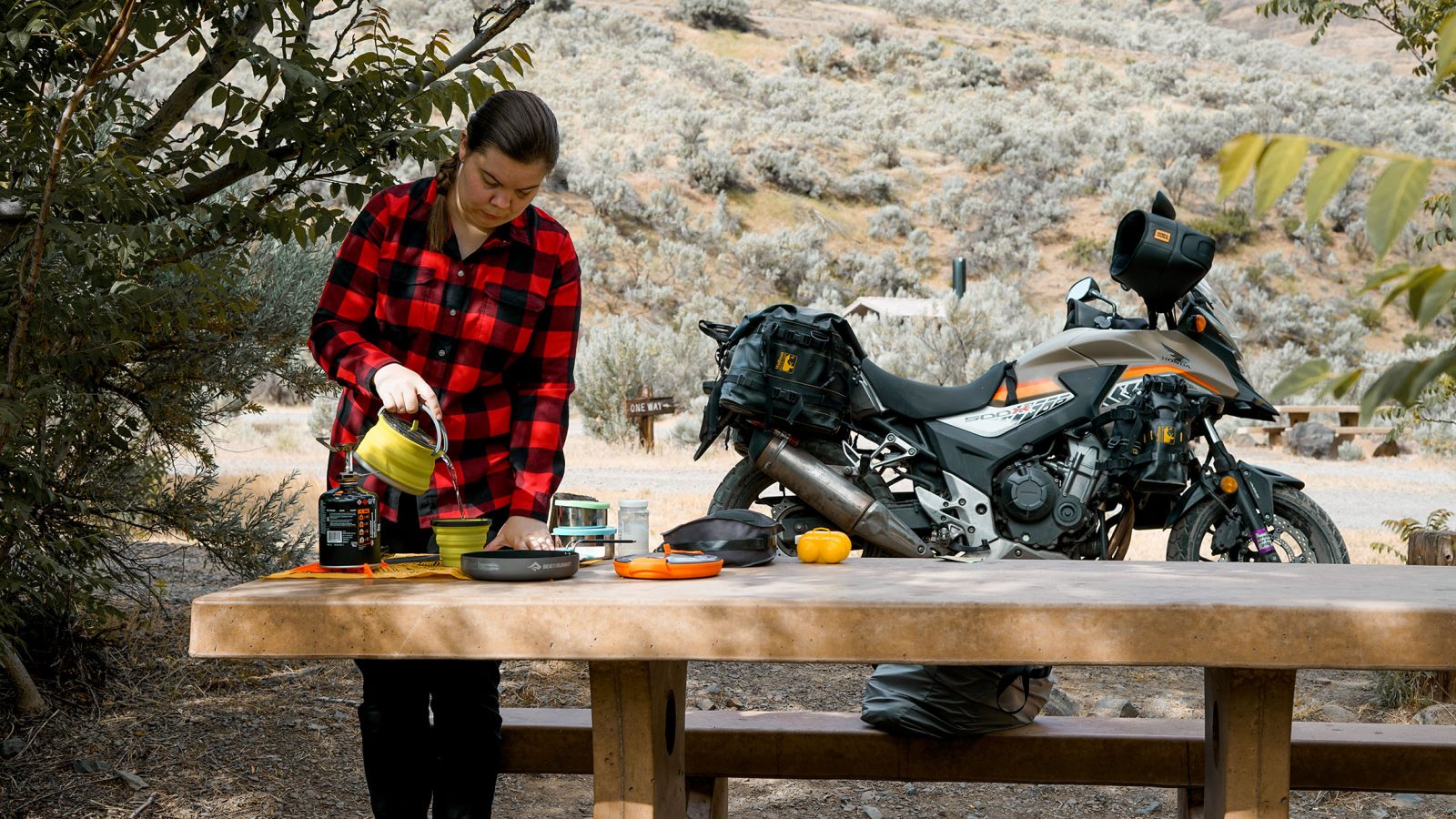
Safety in Camp and on the Road
Depending on the areas you’ll be traveling through and camping, you’ll want to consider the wildlife (and other humans) you could encounter—this is where the old saw “an ounce of prevention is worth a pound of cure” can really come into play.
Animal Safety—Bears and More
If you’re in a bear-active area, read up on information from credible sources for the best way to take care of your food and anything with a smell (i.e. toothpaste, deodorants, soaps, etc.) when you’re in bear country. That is imperative for your protection but also the protection of the animals. Some bear active recreation areas will require you to carry a bear canister and bear spray. Don’t just bring them, read the instructions, understand how they work, and watch a few videos online so you’re ready to use them. Some brands even offer “practice” cans of bear spray without the capsaicin (the pepper part of pepper spray) to let you draw and fire to see how far and fast the spray travels.
Even if you’re camping in an area that doesn’t see a lot of big game activity, it’s important to keep your food stored away from your tent, and clean up your food immediately after you’re done with it, and put it away between meals. Keeping your food, kitchen equipment, AND trash, tidy and cleaned up is important to protect it from any rodents and birds—which are the most frequent campsite visitors.
Travel Safety
I can’t emphasize enough how helpful simple things are like being aware of your surroundings, knowing your exits, not putting yourself in a position where you can’t get out in a hurry, listening to your gut if you don’t feel comfortable, or if you genuinely don’t feel safe. But don’t let your brain go over the top imagining scenarios that only happen one time out of a million.
I tend not to leave the bike alone when it’s fully packed. If I go into a restaurant to eat, I will try to find a restaurant that has a big window that faces the parking lot and ask to be seated in a place where I can keep an eye on my bike. I also always bring valuable items like electronics with me, whenever I leave the bike for more than five minutes, even if I’m just popping into a grocery store. Something I learned after having a tripod stolen in a National Park, is that people go for the easy-to-grab items that they can see. The more well-packed you are so everything is stowed away and not in the open the less likely someone is to steal it. When I go camping I’m normally in that place for one night and I move on. If I’m planning on spending more than one night in a place I tend to gravitate towards campgrounds with a camp host, so I know someone is making the rounds on the regular.
That’s a start anyway, if you’re still hesitant because you’re worried about other people, there are lots of great basic self-defense classes all over the place that can really help boost your confidence and courage.
I know that just scratched the surface, but it is a BIG topic!
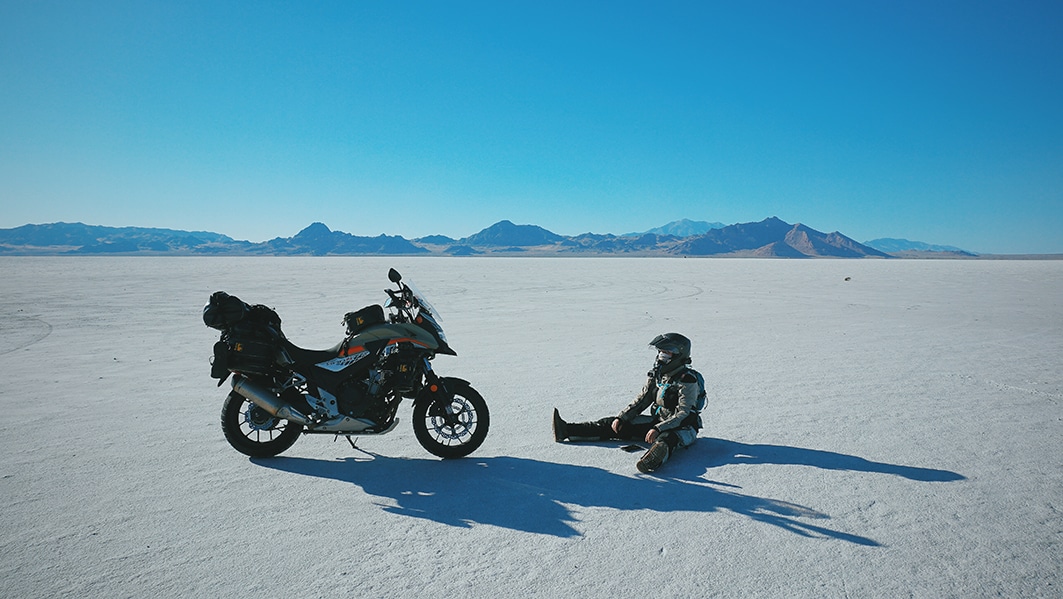
Getting Gear On A Budget
Let’s face it, camping gear is expensive. Here are a few tips for getting the gear you need and being as budget-friendly as possible.
In a nutshell:
- Do your research, look for an older model year.
- Buy Strategically during the off-season and Seasonal Sales.
- Check Online Discount Websites.
- Buy USED from local thrift stores and online for used outlets.
I have a whole video on the topic of buying camping quality camping gear on a budget that you can watch here.
Additional Resources
These are the need-to-know basics for getting into off-road camping, but I have a lot more resources specific to motorcycle camping and for those who are interested in diving deeper. Here are a few I recommend:
- Video: How I Chose My Motorcycle Saddlebags
- Video: What If I Break Down On My Trip?
- For everything you could need, I recommend The Fundamentals of Motorcycle Camping by my friend Tim Collins.
- Check out the beginner off-road trails near you.
GPS Off-Road Map App Built for Adventure
Use the most trusted GPS for off-roading and snowmobiling app, onX Offroad, to discover nearby trails, plan and build routes in 3D, track your trips, and get home safely.
